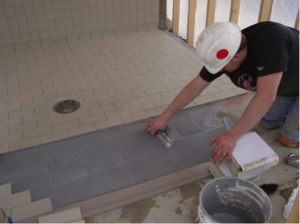MATERIALS OF CONSTRUCTION Fired Up About Vitrified Tiles
MATERIALS OF CONSTRUCTION Fired Up About Vitrified Tiles
If you’ve done any kitchen or bathroom remodeling lately, you probably looked at miles of tiles—glass, porcelain, glazed, and natural materials like granite, soapstone, and marble. Some suppliers might have referred to the glass, porcelain, and glazed tiles as vitrified tiles, while the other tiles might have been categorized as stone or natural tiles. You probably learned that vitrified tiles are less porous and easier to keep clean, while natural tiles are often favored for their tactile and aesthetic features. But did you know that, for the same reasons vitrified tiling is a good choice for kitchens and bathrooms, it can be good for industrial flooring where sanitation is critical? For decades European manufacturers benefited from ready access to non-absorbent, fully-vitrified  industrial floor tile. This type of tile has gained favor in North America over the last ten years, yet many industry professionals are still unclear about the performance benefits of fully-vitrified tiles. Impervious, fully-vitrified floor tiles fit well into industrial food, beverage, and pharmaceutical processing environments. The tiles are very dense and do not support bacterial or fungal growth. When vibration-set in high-strength adhesive and grouted with epoxy, these strong tiles provided a durable, long-lasting floor. Numerous surface texture options offer different degrees of slip resistance, while a range of color choices provides architectural diversity. Highly chemical- and thermal-resistant, these tiles can stand up to harsh sanitizers and frequent steam or hot water cleaning.
industrial floor tile. This type of tile has gained favor in North America over the last ten years, yet many industry professionals are still unclear about the performance benefits of fully-vitrified tiles. Impervious, fully-vitrified floor tiles fit well into industrial food, beverage, and pharmaceutical processing environments. The tiles are very dense and do not support bacterial or fungal growth. When vibration-set in high-strength adhesive and grouted with epoxy, these strong tiles provided a durable, long-lasting floor. Numerous surface texture options offer different degrees of slip resistance, while a range of color choices provides architectural diversity. Highly chemical- and thermal-resistant, these tiles can stand up to harsh sanitizers and frequent steam or hot water cleaning.
Light Bright Fully-vitirified tiles in numerous color options offer architectural diversity. Pale color choices enhance light reflection in manufacturing areas.

Strong Adhesive, Strong Floor Not just any joint materials will grab the smooth, dense surfaces of fully-vitrified tiles. High-strength epoxy adhesive and grout, specially formulated with adhesion promoters, do the trick. Vibration setting optimizes contact between the adhesive and tiles at the bed joint.
Vitrification and Classification Let’s begin by defining vitrification. It is a process by which unfired ceramic bodies are turned into a fluid state producing a singular, homogeneous substance. For manufactured ceramic tiles, heat drives the process. As the tiles increase in their degree of vitrification, they approach a glassy state and their capacity to absorb water is reduced. Water absorption is the ratio of the weight of water soaked into the tile divided by its dry weight. ANSI A137.1 divides tiles into four categories by their water absorption.
Water Absorption Vitrification Category
< 0.5% Impervious(Fully-vitrified)
0.5 – 3.0% Vitreous
3.0 – 7.0% Semi-vitreous
>7.0% Non-vitreous
When choosing floor tile for food, beverage, and pharmaceutical plants subject to strict sanitation regulations, water absorption is an important physical property to consider. While ceramic tiles do not support the growth of bacteria, fungi, or molds, the pores in the tiles can harbor microbes and retain life-sustaining fluids. It follows that lower-absorption tiles are inherently more sanitary than higher-absorption tiles, because they have less capacity to support or harbor harmful organisms.
Fully-Vitrified Industrial Tiles
The process of manufacturing fully-vitrified tiles starts with formulation and formation of the ceramic bodies, made from a blend of kaolin clays, feldspar, silica, and coloring oxides and a contraction control agent. To produce unfired ceramic bodies with very low moisture content (less than 6.5%), these raw materials are expertly blended, particle size graded, and dried then precision dust-pressed. Kiln-firing them within a very narrow temperature range (1,135°C to 1,200°C), which varies by manufacturer, produces fully-vitrified tiles.

Integrally molded spacer lugs on the sides of these fully-vitrified tiles create narrow, 2 mm wide joints when butted together.
To achieve different degrees of slip resistance, specially designed molds are used to integrally form a variety of surface textures and patterns protruding from the faces of fully-vitrified tiles. Because these textures are pressed into the tile faces before they are fired, the resulting profiled surface is dense and durable. The slip-resistant pattern covers the entire surface of each tile uniformly.
Fully-vitrified industrial tiles are available in a variety of shapes and colors. Three-quarter inch thick (18 mm) tiles featuring integrally formed spacers come in rectangular and hexagonal shapes as shown. While some architects might choose hexagonal tiles for aesthetic reasons, their shape is also functional. Hexagonal tiles more readily conform to the variable slopes of drainage basin floors.

A combination of light colored hexagonal and rectangular fully-vitrified tiles yields attractive results.
As the level of a ceramic’s vitrification increases, so does abrasion and chemical resistance. Fully-vitrified industrial tiles exhibit superior performance when subjected to wear and tear, as well as aggressive sanitizing chemicals. Fully supported with a bed joint of high-strength adhesive, fully-vitrified industrial tiles perform extremely well under impact loads.
SUMMARY Fully-vitrified industrial floor tiles are an excellent choice for food, beverage, and pharmaceutical plants. A popular choice for kitchens and bathrooms, impervious, non-absorbent, fully-vitrified tiles do not support bacterial or fungal growth. Industrial architects can choose from a variety of surface textures to optimize slip-resistance and cleanability, while numerous color options offer design versatility. These highly chemical- and stain-resistant tiles can stand up to aggressive sanitizing and processing chemicals, as well as day-to-day wear and tear.

